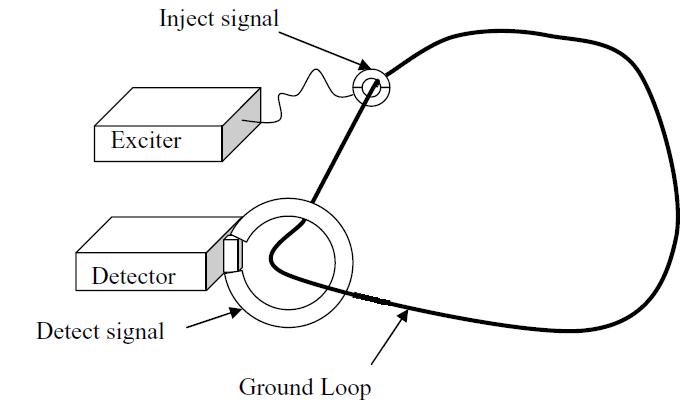US Patent 7,791,353 B2
Introduction
Simple Circuit Concepts
Transmission lines
Faraday's law
Near and far fields
Spurious coupling mechanisms
- Direct conduction
- Capacitive coupling -problem
- Capacitive coupling -fixing
- Inductive coupling-problem
- Inductive coupling -fixing by twisted
- Inductive coupling -fixing by coax
- Electromagnetic pickup
- Examples
- Safety & star grounding
- Gnd loop resistance, inductance
- Low frequency behavior
- High frequency behavior
- Troubleshooting
- Methods for removing
Troubleshooting ground loops
A traditional method for finding ground loops is to disconnect all cables and then re-connect them one-by-one until the ground loop re-appears. In complex systems having many cables this is not only tedious but may fail because disconnecting cables might disable the configuration being examined. For example, if the ground loop results from one set of cables inducing a current in another, then disconnecting all the cables will make it impossible to find the ground loop. A hand-held device has recently been developed to enable a systematic means for diagnosing ground loops. An important feature of this device, called the Loop Slooth <http://www.LoopSlooth.com/>, is that no cable has to be disconnected during the diagnosis, i.e., the circuit remains intact during the diagnosis. This is because the Loop Slooth does not physically contact the system under test. The Loop Slooth consists of an Exciter module and a Detector module, each having its own batteries and power switch.
A traditional method for finding ground loops is to disconnect all cables and then re-connect them one-by-one until the ground loop re-appears. In complex systems having many cables this is not only tedious but may fail because disconnecting cables might disable the configuration being examined. For example, if the ground loop results from one set of cables inducing a current in another, then disconnecting all the cables will make it impossible to find the ground loop. A hand-held device has recently been developed to enable a systematic means for diagnosing ground loops. An important feature of this device, called the Loop Slooth <http://www.LoopSlooth.com/>, is that no cable has to be disconnected during the diagnosis, i.e., the circuit remains intact during the diagnosis. This is because the Loop Slooth does not physically contact the system under test. The Loop Slooth consists of an Exciter module and a Detector module, each having its own batteries and power switch.
Find ground loops fast!
-eliminate electical interference, fix star grounding
-eliminate electical interference, fix star grounding
US Patent 7,791,353 B2

Figure 14 Loop Slooth Exciter drives current in ground loop; Loop Slooth Detector detects this current; moving detector traces out path of ground loop.
As shown in Fig. 14, the Exciter module creates a time-dependent (100 kHz) magnetic flux linked to the ground loop via a clamp-on current transformer; this produces a 100 kHz loop voltage Vloop. If the loop is complete (i.e., there is a low resistance path around the loop), the loop voltage Vloop will drive a 100 kHz current Iloop around the loop with magnitude | Iloop |=Vloop/(2pfLloop). The Detector module measures the 100 kHz magnetic field produced by this current Iloop via a magnetic sensing coil that also links the ground loop. By moving the detector the physical path of the ground loop path can be traced.
The ground loop current might branch into sub-paths like water flowing in a large pipe branching to flow into two or more smaller pipes. The Loop Slooth Detector meter enables tracking this branching as follows:
Suppose the Detector meter reads 500 when both Exciter and Detector are linked to an instrument power cord thereby indicating existence of a ground loop incorporating the power cord ground wire. Suppose the detector is then linked to the various cables coming out of the instrument and the meter indicates 400 when linked to one suspect cable and then indicates 100 when linked to another suspect cable. These readings mean that the ground loop current has divided into two branches, one carrying 80% of the ground loop current and the other carrying 20%. The first cable is part of the 80% branch while the second cable is part of the 20% branch. Eliminating the large-current branch typically forces all the ground loop current to flow in the remaining branch, i.e., breaking the path of the 80% branch will typically cause the ground loop current in the 20% branch to jump from 100 to 500. If the 20% branch was the part of the configuration that was most sensitive to ground loop currents, then breaking the path of the 80% branch will actually make matters worse. This situation where the ground loop current jumps around as branches are eliminated is analogous to damming up one of two parallel streams at the base of a large waterfall so that all the water that previously flowed in the dammed-up stream is diverted to the stream that is not dammed up. Complete clean-up requires identifying and removing all branches of the ground loop system; this task is made feasible using the Detector meter to identify the branching.